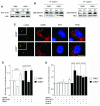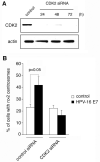Cyclin-dependent kinase 2 is dispensable for normal centrosome duplication but required for oncogene-induced centrosome overduplication
- PMID: 16331279
- PMCID: PMC2225596
- DOI: 10.1038/sj.onc.1209310
Cyclin-dependent kinase 2 is dispensable for normal centrosome duplication but required for oncogene-induced centrosome overduplication
Abstract
Cyclin-dependent kinase 2 (CDK2) has been proposed to function as a master regulator of centrosome duplication. Using mouse embryonic fibroblasts (MEFs) in which Cdk2 has been genetically deleted, we show here that CDK2 is not required for normal centrosome duplication, maturation and bipolar mitotic spindle formation. In contrast, Cdk2 deficiency completely abrogates aberrant centrosome duplication induced by a viral oncogene. Mechanistically, centrosome overduplication in MEFs wild-type for Cdk2 involves the formation of supernumerary immature centrosomes. These results indicate that normal and abnormal centrosome duplication have significantly different requirements for CDK2 activity and point to a role of CDK2 in licensing centrosomes for aberrant duplication. Furthermore, our findings suggest that CDK2 may be a suitable therapeutic target to inhibit centrosome-mediated chromosomal instability in tumor cells.
Figures




Similar articles
-
Cdk2 and Cdk4 regulate the centrosome cycle and are critical mediators of centrosome amplification in p53-null cells.Mol Cell Biol. 2010 Feb;30(3):694-710. doi: 10.1128/MCB.00253-09. Epub 2009 Nov 23. Mol Cell Biol. 2010. PMID: 19933848 Free PMC article.
-
RNA polymerase II transcription is required for human papillomavirus type 16 E7- and hydroxyurea-induced centriole overduplication.Oncogene. 2007 Jan 11;26(2):215-23. doi: 10.1038/sj.onc.1209782. Epub 2006 Jul 3. Oncogene. 2007. PMID: 16819507 Free PMC article.
-
Roles of cyclins A and E in induction of centrosome amplification in p53-compromised cells.Oncogene. 2008 Sep 11;27(40):5288-302. doi: 10.1038/onc.2008.161. Epub 2008 May 19. Oncogene. 2008. PMID: 18490919 Free PMC article.
-
P53, cyclin-dependent kinase and abnormal amplification of centrosomes.Biochim Biophys Acta. 2008 Sep;1786(1):15-23. doi: 10.1016/j.bbcan.2008.04.002. Epub 2008 Apr 22. Biochim Biophys Acta. 2008. PMID: 18472015 Free PMC article. Review.
-
Centrosome overduplication, chromosomal instability, and human papillomavirus oncoproteins.Environ Mol Mutagen. 2009 Oct;50(8):741-7. doi: 10.1002/em.20478. Environ Mol Mutagen. 2009. PMID: 19326465 Review.
Cited by
-
MPS1 is involved in the HPV16-E7-mediated centrosomes amplification.Cell Div. 2021 Nov 4;16(1):6. doi: 10.1186/s13008-021-00074-9. Cell Div. 2021. PMID: 34736484 Free PMC article.
-
The G1 phase Cdks regulate the centrosome cycle and mediate oncogene-dependent centrosome amplification.Cell Div. 2011 Jan 27;6:2. doi: 10.1186/1747-1028-6-2. Cell Div. 2011. PMID: 21272329 Free PMC article.
-
Oncogenic activities of human papillomaviruses.Virus Res. 2009 Aug;143(2):195-208. doi: 10.1016/j.virusres.2009.06.008. Epub 2009 Jun 18. Virus Res. 2009. PMID: 19540281 Free PMC article. Review.
-
The human papillomavirus E7 oncoprotein.Virology. 2009 Feb 20;384(2):335-44. doi: 10.1016/j.virol.2008.10.006. Epub 2008 Nov 12. Virology. 2009. PMID: 19007963 Free PMC article. Review.
-
Cullin 1 functions as a centrosomal suppressor of centriole multiplication by regulating polo-like kinase 4 protein levels.Cancer Res. 2009 Aug 15;69(16):6668-75. doi: 10.1158/0008-5472.CAN-09-1284. Cancer Res. 2009. PMID: 19679553 Free PMC article.
References
Publication types
MeSH terms
Substances
Grants and funding
LinkOut - more resources
Full Text Sources
Molecular Biology Databases

